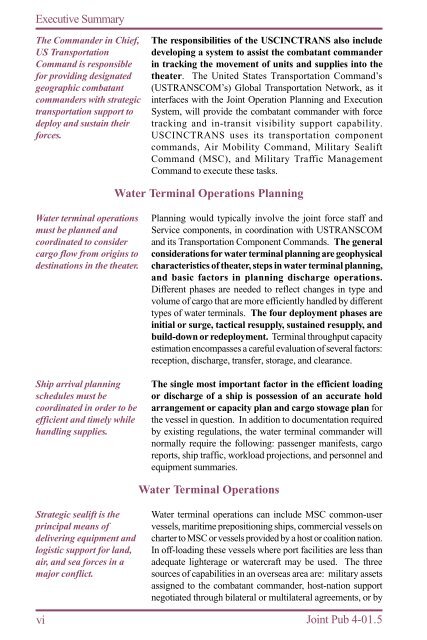JP 4-01.5 JTTP for Water Terminal Operations - BITS
JP 4-01.5 JTTP for Water Terminal Operations - BITS
JP 4-01.5 JTTP for Water Terminal Operations - BITS
Create successful ePaper yourself
Turn your PDF publications into a flip-book with our unique Google optimized e-Paper software.
Executive Summary<br />
The Commander in Chief,<br />
US Transportation<br />
Command is responsible<br />
<strong>for</strong> providing designated<br />
geographic combatant<br />
commanders with strategic<br />
transportation support to<br />
deploy and sustain their<br />
<strong>for</strong>ces.<br />
<strong>Water</strong> terminal operations<br />
must be planned and<br />
coordinated to consider<br />
cargo flow from origins to<br />
destinations in the theater.<br />
Ship arrival planning<br />
schedules must be<br />
coordinated in order to be<br />
efficient and timely while<br />
handling supplies.<br />
Strategic sealift is the<br />
principal means of<br />
delivering equipment and<br />
logistic support <strong>for</strong> land,<br />
air, and sea <strong>for</strong>ces in a<br />
major conflict.<br />
vi<br />
The responsibilities of the USCINCTRANS also include<br />
developing a system to assist the combatant commander<br />
in tracking the movement of units and supplies into the<br />
theater. The United States Transportation Command’s<br />
(USTRANSCOM’s) Global Transportation Network, as it<br />
interfaces with the Joint Operation Planning and Execution<br />
System, will provide the combatant commander with <strong>for</strong>ce<br />
tracking and in-transit visibility support capability.<br />
USCINCTRANS uses its transportation component<br />
commands, Air Mobility Command, Military Sealift<br />
Command (MSC), and Military Traffic Management<br />
Command to execute these tasks.<br />
<strong>Water</strong> <strong>Terminal</strong> <strong>Operations</strong> Planning<br />
Planning would typically involve the joint <strong>for</strong>ce staff and<br />
Service components, in coordination with USTRANSCOM<br />
and its Transportation Component Commands. The general<br />
considerations <strong>for</strong> water terminal planning are geophysical<br />
characteristics of theater, steps in water terminal planning,<br />
and basic factors in planning discharge operations.<br />
Different phases are needed to reflect changes in type and<br />
volume of cargo that are more efficiently handled by different<br />
types of water terminals. The four deployment phases are<br />
initial or surge, tactical resupply, sustained resupply, and<br />
build-down or redeployment. <strong>Terminal</strong> throughput capacity<br />
estimation encompasses a careful evaluation of several factors:<br />
reception, discharge, transfer, storage, and clearance.<br />
The single most important factor in the efficient loading<br />
or discharge of a ship is possession of an accurate hold<br />
arrangement or capacity plan and cargo stowage plan <strong>for</strong><br />
the vessel in question. In addition to documentation required<br />
by existing regulations, the water terminal commander will<br />
normally require the following: passenger manifests, cargo<br />
reports, ship traffic, workload projections, and personnel and<br />
equipment summaries.<br />
<strong>Water</strong> <strong>Terminal</strong> <strong>Operations</strong><br />
<strong>Water</strong> terminal operations can include MSC common-user<br />
vessels, maritime prepositioning ships, commercial vessels on<br />
charter to MSC or vessels provided by a host or coalition nation.<br />
In off-loading these vessels where port facilities are less than<br />
adequate lighterage or watercraft may be used. The three<br />
sources of capabilities in an overseas area are: military assets<br />
assigned to the combatant commander, host-nation support<br />
negotiated through bilateral or multilateral agreements, or by<br />
Joint Pub 4-<strong>01.5</strong>
















